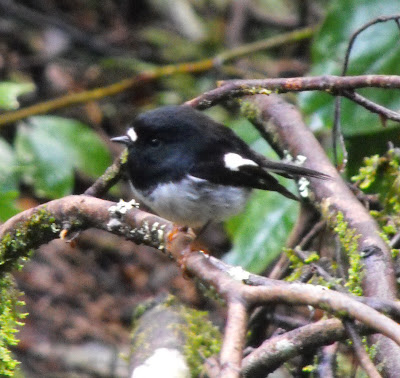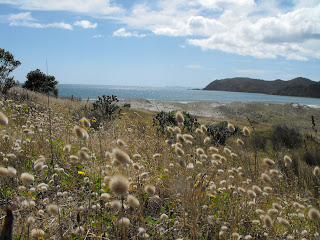A year has passed since we sold our Bach in Tuateawa. Surprisingly, after nearly forty years, there are still things undone and unseen. A Maori carving on the shore, often sought and never found. More Maori carvings, dendroglyphs, on cabbage trees in the Colville region. The list is quite a large one. It is the measure of an interesting area that there are always new things within it to be discovered!
There are also many things to remember. All Tuateawans are familiar with the mason bee. It makes muddy cavities within which it places paralysed black spiders. A larder for it's developing young. Annoying when the locations chosen happen to be folds in your curtains. Totally explosive when the unfortunate spider is entombed within the entrails of your TV!
 Sometimes you see something, the significance of which eludes you for many years. It is a while back now, late one afternoon during a southerly storm in May. Tens of thousands of mutton birds, all travelling in the same direction came in across the sea from the south. They passed below our bach window for hour after hour and there seemed to be no end to them. Some years later we realised that we had seen the northern mutton bird migration heading for summer of the coast of California. They are known to move up the east coast of NZ. from the deep south. Maybe they were heading over the Peninsula at Tuateawa and on into the Firth of Thames.
Sometimes you see something, the significance of which eludes you for many years. It is a while back now, late one afternoon during a southerly storm in May. Tens of thousands of mutton birds, all travelling in the same direction came in across the sea from the south. They passed below our bach window for hour after hour and there seemed to be no end to them. Some years later we realised that we had seen the northern mutton bird migration heading for summer of the coast of California. They are known to move up the east coast of NZ. from the deep south. Maybe they were heading over the Peninsula at Tuateawa and on into the Firth of Thames.Birds are such a part of Tuateawa. Tuis are ever present and particularly aggressive in the summer months. Such that our resident heavy was known as Tui the Terminator, capable of a complete barrel roll in pursuit of any bird that challenged his supremacy.
Now we are getting to know many more places, but none of them as well. Tuateawa is our reference point and it stands up remarkably well to all comparisons. Early this summer we climbed Whanake and then, within a week, also clambered up Mt. Te Aroha.
Te Aroha is a majestic maunga and dominates the Waikato. It has many things that Whanake lacks. A goblin forest near the summit with the trees heavily festooned with lichen. An alpine herb field, remnant of the last ice age. It is so much higher than Whanake, has some magnificent vegetation, but, in some ways it is lesser.
There are far fewer birds, it's slopes are dotted with pines and eucalypts and many of the emergent trees are dead. It is easy to see why, possum droppings are abundant, and only the less succulent plant seedlings are found on the forest floor.
Tuateawa has a much higher level of pest control both from within the community and from other national and local bodies. The difference shows. Mt Te Aroha does receive a considerable spend. The old Tui Mine tailing dam is costing millions to stabilise. D.O.C. also protects the relics of the mining era on the mountain and some significant stands of rata. There just isn't enough money to protect everything.
More recently we spent some time on Gt. Barrier Island, just of the tip of the Coromandel Peninsula.
It has similar magnificent scenery and it's own iconic species, some of which the Coromandel shares, like the kaka and brown teal to mention a couple.
Given that GBI has no possums, hedgehogs or mustelids you would expect the bird life to be thriving but it is not so. It is generally acknowledged that this is due to the populations of rats and feral cats. There is a notable community response to this situation. Currently there is a smallish predator proof fenced enclosure at one end of the island, a predator free offshore island nearby and another area of predator control at the other end of the island. The later has seen the reintroduced robin increase and move out of it's initial area. Moves are afoot to make the whole island rat free, a massive undertaking and one needing the whole community to be of like mind.
When we look at community and Govt. conservation initiatives very few of them have been running for a long time. They are really just in an early trial stage. Governance issues within the world leading Maungatautari Project illustrate the concerns that some have expressed over the long term viability of many conservation programmes. Conservation isn't something that can be stopped. It has to be for ever. Less Govt. money is going DOC's way these days and legislative changes are not always favourable to the environment. The onus is increasingly falling on local groups. On the positive side there seems to be a ground swell of public opinion in favour of the environment. So many communities are now not only trying to conserve what they have but also attempting to bring back what they have lost. Habitat Tuateawa is one of the longest running environmental groups in the country. It has helped to bring about remarkable changes in the area. It is this very fact that will help it to continue long into the future.

















.JPG)






+-+Copy.JPG)





+-+Copy.JPG)

.JPG)

.JPG)
.JPG)
.JPG)



.JPG)






.JPG)
